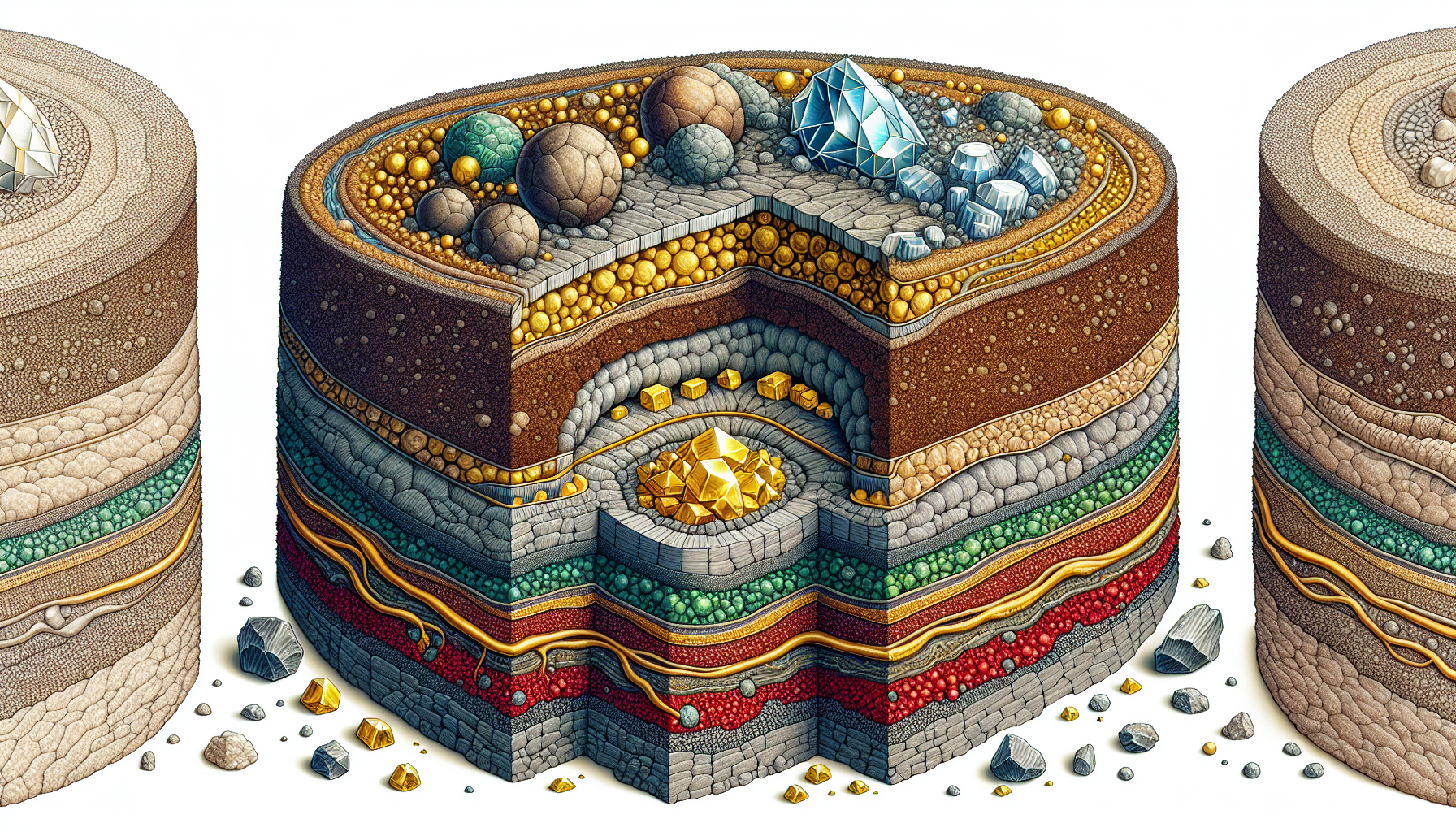Published: Apr 02, 2024 | Updated at: Apr 02, 2024
Discovering and managing mineral rights and royalties in Texas’s oil and gas sector can be simplified with Halsell. Our Productivity Suite serves as your ally, offering streamlined solutions for the complex task of identifying and acquiring these valuable assets. This article will guide you through the essentials of the energy market and showcase how Halsell equips you with the necessary tools for success.
Key Takeaways
Mineral rights in Texas allow owners to extract and profit from resources such as oil and gas found beneath their land, but selling these rights requires thoughtful consideration of tax implications and market value.
Oil & gas royalties are payments to mineral rights owners based on a percentage of the production value, typically ranging from 12.5% to 25%, which can represent a significant income source.
Locating and acquiring mineral rights and royalties involve identifying geologically rich areas, conducting thorough title searches, and utilizing tools like Halsell.com Productivity Suite to streamline the process.
Key Takeaways
Diving into the world of mineral rights and oil & royalties can seem daunting, but with the right tools and guidance, it’s a journey filled with opportunities. As an owner of Texas mineral estate, you have a unique opportunity to extract resources such as:
oil
salt
uranium
sulfur
From your land, you can tap into the wealth of natural resources like oil and natural gas, all available for free extraction at your location. With Texas being rich in resources and hosting major shale plays, understanding these assets becomes all the more crucial to harness their power and support their sustainable utilization.
However, selling mineral rights in Texas isn’t a decision to be taken lightly. It requires careful consideration of tax implications, especially concerning the step-up in basis for inherited mineral estates. It’s also essential to be wary of mineral flippers and brokers who may not offer fair value for the rights.
What are Mineral Rights?

In essence, mineral rights refer to ownership claims over the natural resources found beneath the surface of a property, such as:
oil
coal
metals
ores
mineable rocks
They’re distinct from surface rights, which involve usage of the land for residential, agricultural, or commercial purposes.
In some regions, such as Texas, Oklahoma, and Pennsylvania, these rights can be ‘severed’ from surface rights, leading to separate ownership. Owners of mineral rights can sell them to private corporations, potentially earning significant royalties, especially if the resources are valuable like subterranean oil reserves.
However, the value of mineral rights and the corresponding royalties can fluctuate with the market price of resources like oil. Therefore, it’s essential for buyers to verify whether they are obtaining both surface and mineral rights by examining land title records.
What are Oil & Gas Royalties?

The link between mineral rights and oil & gas royalties is straightforward. Oil royalties are payments received by mineral rights owners based on a percentage of revenue from the production and sale of the resources extracted from their property.
The royalty payments to landowners from oil and gas production are typically negotiated between 12.5% to 25% of the value of the extracted resources. These percentages might seem small, but given the high value of oil and gas, they can translate into substantial income for the rights owners.
The Different Types Of Mineral & Royalty Interests
Understanding the different types of mineral and royalty interests is crucial to navigating the oil and gas industry, especially if you end on buying and/or selling mineral and royalty interests. Some interests can have depth restrictions or well bore restrictions depending on how the interest was originated and should be carefully examined to ensure each party knows what they are transacting before executing a conveyance agreement between parties.
Working Interest (WI): A working interest is the right to explore and produce oil and gas from a property. A working interest expires when the oil and gas lease expires which usually ends when the production stops produces oil and gas.
Overriding Royalty Interest (ORRI): Usually a carve out from the working interest, receives a royalty payment from the production of oil and gas and expires when the lease expires.
Mineral Interest (MI): has the executive rights to negotiate and execute an oil and gas lease and receive lease bonus payments.
Non-executive Mineral Interest (NEMI): Some owners might have a Non-Executive Mineral Interest, which does not have the executive rights to negotiate and execute an oil and gas lease but does participate in the lease bonus payments.
Royalty Interest (RI): a royalty interest receives royalty payments from the production of oil and gas from the well.
Non-participating Royalty Interest (NPRI): A NPRI established by leasing a part of the Working Interest to a third party, providing a right to a share of the production, excluding costs associated with the mineral lease.
How to calculate a Net Revenue Interest on an Oil & Gas Lease
Understanding the financial implications of owning mineral rights and receiving royalties requires some calculations. To calculate the Net Revenue Interest (NRI) on an oil & gas lease, you multiply the Share of Interest by the Royalty Rate. It’s also essential to consider the average oil and gas royalty payments when evaluating the potential income from these assets.
How to Calculate Net Mineral Acres and Net Royalty Acres
Beyond understanding the basics of mineral rights and oil royalties, it’s essential to know how to calculate net mineral acres and net royalty acres. These calculations involve considering:
the sales price of oil and gas
deductions from gross revenue
production volume
lease agreement terms
type of lease
fractional interest
the calculation method stipulated in the lease.
Oil Lease Royalty Rate
When it comes to the oil lease royalty rate, there are several factors to consider. The royalty rate, which typically ranges from 12.5% to 25%, determines the share of revenue allocated to the royalty owner from the sale of oil and gas. To estimate the full value of a property, mineral rights owners need to first determine their net mineral acres and net royalty acres.
Land ownership encompasses various rights, including surface rights, timber rights, and mineral rights, including those for oil and gas. Oil companies may lease mineral rights and agree to commence drilling within a certain time frame, often three years, to keep the lease active. When signing a lease agreement, landowners receive a lease bonus payment, and once production begins, they earn royalties from every barrel of oil produced on their property.
Historically, the standard royalty interest given to property owners was one-eighth of the production, but this standard may vary. If an oil reservoir extends under multiple leases, the field may be unitized, and each royalty interest owner receives a share of the total production proportional to their land’s acreage within the unit.
Price Per Net Mineral Acre
The price per net mineral acre is influenced by the unit size, net acres owned within the production unit, and the lease royalty rate agreed upon in the lease contract. The value of net mineral acres is derived by multiplying the gross acreage by the owner’s mineral interest percentage.
The value of producing mineral rights, which have active oil or gas wells, is calculated based on the economic viability of the extracted resources and typically involves periodic royalty payments to the rights owners. On the other hand, non-producing mineral rights, which are interests in land without active wells, can still hold value, particularly if they’re located in regions with high potential for drilling.
Price Per Net Royalty Acre
When determining the price per net royalty acre, the current market price of oil and gas, which directly influences the revenue from royalty payments, is essential to consider. The price per net royalty acre can be calculated by taking the offer to purchase and dividing it by the NRA, which is the product of net mineral acres and royalty rate.
To calculate the price per net royalty acre, follow these steps:
Convert the net mineral acres (NMA) you own into net royalty acres (NRA) by assuming a standard lease royalty rate of 1/8th (12.5%).
Convert the royalty rate to a decimal value by dividing it by 100 (e.g., 12.5% becomes 0.125).
Divide the decimal royalty rate by 0.125.
How to Find and Locate Mineral Rights and Royalty Interests

Now that we’ve covered the basics of mineral rights, royalties, and how to calculate their value, let’s delve into the process of finding and locating these assets. This process involves:
Understanding geological areas rich in oil & gas
Hiring a petroleum landman
Running title searches on mineral rights
Using county appraisal records
Geological Areas Rich with Oil & Gas
The first step in finding mineral rights involves identifying geological areas rich in oil & gas. Some of the prominent regions for oil and gas exploration in the United States include:
The Permian basin of West Texas
The Eagle Ford play
The Haynesville play
The Marcellus Shale
The Scoop Stack play
Geologists use seismic surveys on land and in the ocean to identify potential drilling sites for oil and natural gas. Exploratory wells are drilled and tested in promising sites to assess the viability of oil extraction. If the exploratory wells prove financially worthwhile, development wells are drilled to access oil and natural gas.
The Midland basin and Delaware basin, two sub basins within the greater Permian basin region, are the most prolific oil and gas basin in the United States and currently have the most active drilling rigs and highest horizontal permits submitted for future drilling.
Hire a Petroleum Landman
Once you’ve identified potential areas rich in oil & gas, it can be beneficial to hire a petroleum landman. Petroleum landmen work on tasks such as:
Title research
Asset management
Strategic decision-making within oil and gas exploration companies
They are professionals with strong communication skills, analytical capabilities, and experience in the oil and gas company or real estate, making them valuable assets to any employer.
Run Title Search on Mineral Rights
Running a title search or performing a title opinion on mineral rights is a critical step in the process of locating the ownership of these assets. This involves performing due diligence in county records to figure out who owns what. This step ensures that you have accurate information about the ownership of the mineral rights you’re interested in and they fractional interest owned in that particular tract of land.
County Appraisal Records
In addition to performing a title search or title opinion, it’s also beneficial to consult county appraisal records. These records can provide information about:
the property’s ownership history
any previous links to oil and gas companies
the last person who possessed the rights, which is crucial for understanding the current ownership status.
Use Halsell.com Productivity Suite to Source & Buy Oil & Gas Mineral Rights and Royalties
Having covered the basics of finding and locating mineral rights and royalty interests, let’s explore how Halsell.com Productivity Suite can streamline this process. This suite offers a range of software solutions that make it easier to source and buy oil & gas mineral rights and royalties.
Locate & Assign Prospective Mineral Owners to Landman
One of the features of Halsell.com Productivity Suite is the ability to search by lease or county and assign mineral owner leads to your landman. This feature allows for efficient organization and delegation of tasks, which can significantly improve the process of locating prospective mineral owners.

Call and Text Mineral Owner
Another feature of Halsell VoIP is the ability to:
Call and text prospects directly through your browser
This feature eliminates the need for separate communication tools
Allows you to connect with potential mineral owners quickly and efficiently.

Bulk Email Campaigns
Halsell.com Productivity Suite offers the following features:
Syncing your personal email account for outbound emails
Running bulk email campaigns
Saving time and reaching a large number of potential mineral owners with ease
Halsell Esign
Obtaining electronic signatures on agreements is made easier with Halsell’s e-signature solution, Halsell Esign. This feature ensures that agreements are signed faster and more securely, allowing for a more efficient and reliable transaction process.

Offer Letter Generator
The suite also includes an automated offer letter generator, which enables you to quickly draft offer letters with one click for the desired properties. This feature eliminates the need for manual drafting and ensures that you can make offers to potential mineral owners promptly and effectively.

Close Deal
Finally, Halsell.com Productivity Suite integrates Texas appraisal roll data from 2014 to 2023 to streamline mineral ownership research, allowing users to:
Close deals more efficiently
Calculate net mineral and royalty acreage instantly
Link mineral ownership information to each mineral owner for ease of access
The suite includes an AI-powered auto dialer that allows users to follow up with leads more effectively, distinguishing between human and voicemail responses. The integrated tools and AI capabilities help users outpace competition and close more deals by reducing overhead costs and streamlining the business process.
Conclusion

Understanding mineral rights, oil royalties, and the process of locating and buying them in Texas is not just a subject of academic interest, but a crucial aspect of successful participation in the energy industry of the region. The intricate world of mineral rights and royalties in Texas is rich with opportunities for those ready to delve into it.
The process of locating and buying these assets involves a series of steps, including:
Understanding geological areas rich in oil & gas
Hiring a petroleum landman
Running title searches on mineral rights
Using county appraisal records
Tools like the Halsell.com Productivity Suite, a comprehensive platform, can greatly simplify this process and help you navigate the complex landscape of mineral rights and royalties in Texas.
Summary
We’ve journeyed through the complex world of mineral rights and oil & gas royalties in Texas. We started with an understanding of what mineral rights and oil royalties are and delved deeper into the different types of mineral and royalty interests. We also learned how to calculate a Net Revenue Interest on an Oil & Gas Lease, as well as net mineral acres and net royalty acres.
We then navigated the process of finding and locating mineral rights and royalty interests, understanding geological areas rich in oil & gas, hiring a petroleum landman, running title searches on mineral rights, and using county appraisal records. Finally, we explored how Halsell.com Productivity Suite can streamline this process and help you navigate the complex landscape of mineral rights and royalties in Texas.
Frequently Asked Questions
What is Halsell?
Halsell is a productivity suite of software solutions for helping B2B consumers manage their workflow and operations more efficiently.
What does oil and gas do?
Oil and gas are used as fuels to power vehicles and machines, heat buildings, and generate electricity, as well as serving as raw materials for various industrial products such as plastics and solvents. They play a critical role in powering our daily lives and driving various sectors of the economy.
Is oil and gas a dying industry?
The oil and gas industry is not dying. It still provides significant employment and economic contribution, supporting millions of jobs and injecting trillions into the economy annually.
How much income in oil and gas?
The global oil and gas industry's profits in 2022 jumped to some $4 trillion from an average of $1.5 trillion in recent years, showing a significant increase in income. The total revenue of the United States' oil and gas industry in 2022 was 332.9 billion U.S. dollars, a substantial increase from the previous year's 211.2 billion U.S. dollars.
Can mineral rights be inherited or willed to others?
Yes, mineral rights can be inherited or willed to others. It's best to consult an oil and gas attorney for the paperwork.
How are the value of mineral rights determined?
The valuation of mineral rights often requires a professional appraisal, which can be either current or retrospective depending on the situation.
Are selling mineral rights a good financial decision?
Selling mineral rights can be a strategic financial decision, especially if they are valuable and the sale can improve the owner’s life situation.
Do I own the mineral rights if I own the surface rights to land?
If you own the surface rights to land, it doesn’t necessarily mean you own the minerals or royalties beneath it, as these can be severed from the surface estate.
How can I find out who owns the mineral rights to a property?
Mineral rights are public records and with diligent searching, one can find deeds of record, though a full title search is often necessary to determine exact ownership.


